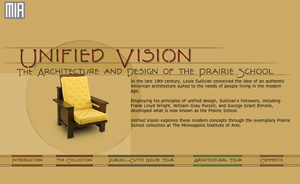talking history | syllabi | students | teachers | puzzle | about us
Unified Vision: The Architecture and Design of the Prairie School
http://www.artsmia.org/unified-vision/
Created by the Minneapolis Institute of Arts.
Reviewed Sept. 2006.
This Web site combines three different, but closely related, bodies of information: a virtual tour of the Purcell-Cutts prairie house (a property of the Minneapolis Institute of Arts), an exhibition catalog of prairie school objects in the collections of the Minneapolis Institute of Arts, and four virtual tours of prairie school buildings in Minnesota.

The Purcell-Cutts house was designed by William Gray Purcell and George Grant Elmslie for Purcell and his family in Minneapolis in 1913. The author of the site tells us that it is one of “the most outstanding examples of Prairie School architecture in the country” for which the architects “followed architect Louis Sullivan’s principles of organic architecture.” That statement conflates Sullivan’s organic system of ornament for Chicago school tall office buildings with Frank Lloyd Wright’s leading role in the prairie school, within which he developed an organic system of architecture. In fact, Elmslie worked for both Sullivan and Wright, and the house is a synthesis of both men’s ideas.
Each page of the house tour features a floor plan, a color photographic view, a modest amount of text, and several thumbnail images inviting further inquiry. Many of the interior and exterior images can be “zoomed” and offer a 360-degree visual experience. Altogether there are thirty-seven exterior and interior pages and two pages of details, each accompanied by a brief explanatory text. Purcell’s notes on the house conclude the tour. The lavishness of the imagery available on this site is warranted by Purcell and Elmslie’s unique synthesis of Sullivan and Wright’s approaches to architecture and decoration.
The second part of the site, “The Collection,” features artifacts designed by Sullivan, Wright, Purcell and Elmslie, and George W. Maher, and eleven additional arts and crafts objects mostly made in Minnesota. Each architect segment contains biographical text, a photographic portrait, and thumbnails that lead to pages on the objects. For Frank Lloyd Wright, for example, there are chairs, metal vases, art glass windows, and tableware. “Table, from a dining set,” includes a photograph of a table and eight side chairs from the George Barton house (1903–1904) in Buffalo, New York. Each object page includes standard museum catalog data and a paragraph of text.
The “Architectural Tour: Prairie School Architecture in Minnesota,” offers four virtual tours, two of places in the vicinity of Minneapolis, one of sites throughout Minnesota, and the fourth of lost arts and crafts buildings. Visitors to the Web site can download the text of the first three tours—replete with large color photographs and maps—and embark on a real tour. The format of the virtual tour follows that of the other parts of the site: on the “Lake of the Isles Tour,” for example, each “stop” features a color photograph of the building, the name of the architect, client, date, and address of the building, several paragraphs of historical text, and thumbnails leading to historic photographs, details, and floor plans. The majority of the buildings are arts and crafts period domestic commissions by Purcell and his partners, as well as works by Maher, Sullivan, and Wright.
A final segment enables the viewer to comment, and it provides an extensive list of positive comments made by previous viewers. Their approbation is well founded, as the Web site provides the opportunity for an intensive exploration of the arts and crafts movement in Minnesota, and it is a model of clarity and easy, linear navigation.
John F. Quinan
State University of New York
Buffalo, New York
